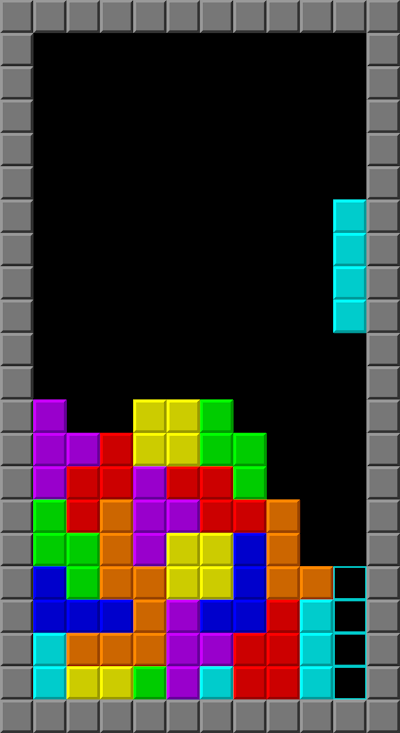With its bright colors, easy-to-learn rules, and familiar music, the Tetris video game has remained a pop culture icon over the past 40 years. Many people, like me, have been playing the game for decades, and it has evolved to adapt to new technologies such as gaming systems, phones, and tablets. However, no one had beaten him until January 2024.
An Oklahoma teenager holds the Tetris title after beating the game by crashing it on Level 157. Beating this means the player moves tiles too fast for the game to keep up with the score, causing the game to crash. AI can suggest strategies that allow players to control game tiles more effectively and place them into place faster; these strategies helped crown the game’s first winner.
But there’s much more to Tetris than the elusive promise of winning. As a mathematician and mathematics educator, I recognize that the game relies on a fundamental element of geometry called dynamic spatial reasoning. The player uses these geometric skills to manipulate game pieces, and playing the game can both test and develop the player’s dynamic spatial reasoning.
Play a game
A Russian computer scientist named Alexey Pajitnov invented Tetris in 1984. The game itself is very simple: the Tetris screen consists of a rectangular game board on which geometric shapes fall. These figures are called tetromino and consist of four squares whose sides are connected in seven different ways.
The game pieces fall one by one from the top and pile up from the bottom. The player can manipulate each falling one by rotating or sliding it and then dropping it to the bottom. When a row is completely filled, it disappears and the player earns points.
As the game progresses, pieces appear at the top faster and when the pile reaches the top of the board, the game ends.
Dynamic spatial reasoning

Manipulating game pieces provides the player with an exercise in dynamic spatial reasoning. Spatial reasoning is the ability to visualize geometric shapes and how they will move in space. Dynamic spatial reasoning is thus the ability to visualize actively moving figures.
The Tetris player must quickly decide where the falling game piece would best fit and move it there. This movement includes both translation, or moving a shape left and right, and rotation, or rotating the shape on its axis in 90-degree increments.
Spatial visualization is partly an innate ability and partly a learned expertise. Some researchers state that spatial skill is necessary for successful problem solving, and this skill is often used alongside mathematical skills and verbal skills.
Spatial visualization is an important component of a mathematical discipline called transformational geometry, which is often first taught in middle school. In a typical transformational geometry exercise, students might be asked to represent a shape with x and y coordinates on a coordinate graph and then describe the transformations (such as translation and rotation) necessary to move the part from one location to another while keeping it stationary. same shape and size.
Reflection and expansion are two other basic mathematical transformations, although not used in Tetris. Reflection translates the image along any line while maintaining the same size and shape, and dilation produces a similar shape by changing the size of the shape.
For many students, these exercises are boring because they involve marking many points on graphs to move the position of a shape. But games like Tetris can help students grasp these concepts in a dynamic and engaging way.
Transformational geometry beyond Tetris
Although it may seem simple, transformational geometry forms the basis of many advanced topics in mathematics. Both architects and engineers use transformations to prepare plans that represent the real world in scale drawings.
Animators and computer graphic designers also use transformation concepts. Animation involves representing the coordinates of a shape in a matrix array and then creating an array that moves it across the screen to change its position. Although animators today use computer programs that move figures automatically, it all depends on translation.
Mathematics and differential geometry also use transformation. The concept of optimization involves representing a situation as a function and then finding the maximum or minimum value of this function. Optimization problems often involve graphical representations in which the student uses transformations to change one or more variables.
Many real-world applications use optimization; For example, businesses may want to know the minimum cost to distribute a product. Another example is finding the size of a theoretical box with the largest possible volume.
All of these advanced topics use the same concepts as the basic moves of Tetris.
Tetris is an engaging and fun video game, and players with transformational geometry skills can find success playing it. Research has found that manipulating rotations and translations within the game can provide a solid conceptual foundation for advanced mathematics in many scientific fields.
Playing Tetris can lead students to future talents in business analytics, engineering, or computer science, and it’s fun. As a math educator, I encourage my students and friends to play.
This article is republished from The Conversation, an independent, nonprofit news organization providing facts and authoritative analysis to help you understand our complex world. Written by Leah McCoy Wake Forest University
Read more:
Leah McCoy does not work for, consult for, own shares in, or receive funding from any company or organization that would benefit from this article, and has disclosed no relevant affiliations other than academic appointments.